Sunday, 13 June 2010
Distance 25 km
Duration 5 hours 45 minutes
Ascent 447 m, descent 347 m
Map 56 of the TOP100 blue series (or Maps 153 and 160 in the new lime-green series)
Topoguide (ref. 6542) Sentier vers Saint-Jacques-de-Compostelle via Vézelay
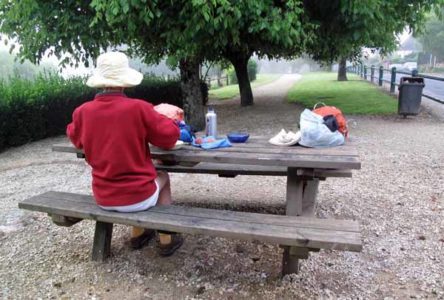
Bergerac camping ground
The threatened flood did not eventuate during the night, although our host had confidently predicted it, as he said it had been raining heavily in the upper Dordogne and the water would take eight hours to arrive. It may have risen a bit while we slept, but no dramatic evacuations were required.
Mist hung low on the river and clung to everything. There were no tables in the camping ground so we lugged our gear out to the adjoining public park and had our muesli there.

All was quiet, including a group of hollow-eyed teenagers propped against a wall, still awake from the festivities of the night before. A few steps further on we came to the bridge and turned away from it to follow the GR southwards.
This side of the river was not the tourist part of Bergerac. There were a few shops, including a boulangerie, where we got a baguette and croissants in the hope of coffee at Montbazillac.
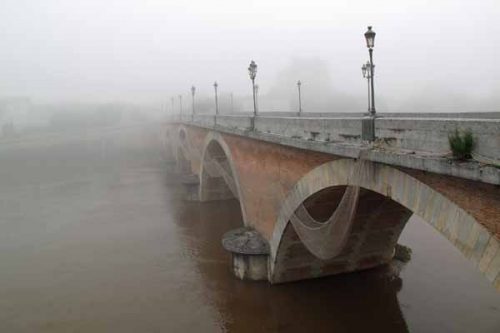
Soon the houses gave way to open fields. There were vines to the left of us and vines to the right of us, and the more we rose, the more vines we could see.
The rose bushes at the ends of the rows traditionally served the purpose of warning the vigneron about the danger of mildew. As the roses were more susceptible than the vines, they succumbed first and gave the growers time to spray or dust the precious grapes.
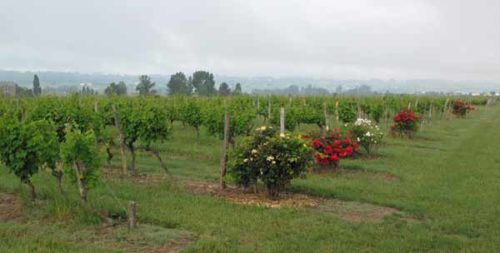
There must also have been prune orchards somewhere near, because we went past a big prune-drying factory with fans the size of jet engines and trucks piled with pallets in the yard.

After a while the GR turned off onto a grassy path through the vines, but we stayed on the bitumen for fear of wet feet. I was hoping that with care my shoes would last another week till the end of our walk – otherwise I would be shuffling along in sandals.
The gradient got more and more severe as we approached Montbazillac, where the many-turreted château presided over its domain with serene authority. There was a parking area worthy of a large supermarket, devoid of cars at this hour (8:30 am).
Beyond was the village and a sorry little place it was. No doubt it springs to life when the château is open to visitors. We saw a sign to a bar/tabac and hurried towards it, only to find that it was closed until 9 o’clock.

Someone was lurking behind the shutters, peeping out, but whoever it was did not seem inclined to open a few minutes early for our sake, so we marched off in the direction of Bouniagues, forsaking the GR once again.
It was about an hour’s walk to Bouniagues along a small road through gently rolling farmland, and as we walked we reflected on the oddity of the human mind.
When walking in the Australian wilderness, where all food and cooking equipment must be carried and there is no chance of coming to a café, it is possible to keep going happily all day.
In France, however, the expectation of such comforts is always in our mind as we approach a village, and when that expectation is dashed, we feel exhausted and indignant.
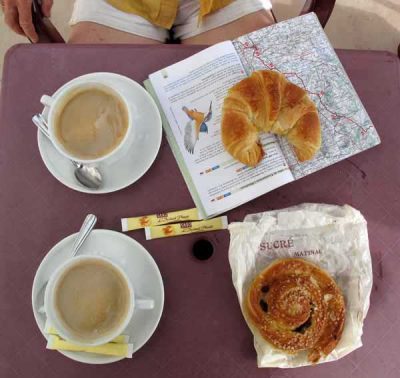
That frame of mind, brought on by Montbazillac, had almost worn off by the time we came down to the highway at the entrance to Bouniagues, but at first glance along the main street, it looked as though we were to be disappointed again. Then at the far end we noticed a large old hotel-bar-restaurant and the sight of a woman sitting on the terrace confirmed that we were in luck – it was open.
With great joy we spread out our pastries from Bergerac under an umbrella, as the sun was now hot, and took off our shoes to air our feet, from which the blisters were now all gone.
Our coffee arrived in lovely wide twelve-sided cups, not the dark green ones with gold edging that are our absolute favourites, but still very handsome. All was forgiven and forgotten in an instant.

While enjoying this moment of repose, we devised a brilliant way to rejoin the GR at Mandacou by using another remnant of the Roman road that we had been following off and on since we left Saint-Astier.
All we had to do was endure a kilometre on the N21 before taking to the parallel Roman road, which was only a wheel track but uncompromisingly straight and a pleasure to walk on.
Unfortunately it merged with the highway again before long, but there was a crooked little road going off to the right, weaving and branching among grassy hills, that took us into the village of Mandacou, where the red and white GR signs reappeared as expected.

The main street was a skinny lane with a token covering of asphalt and at the end stood a remarkably large, handsome church.
Here we turned off the tar on a slimy path down to a watercourse and up again, over a road and onto a fine gravelly track along a ridge, which provided a pleasant lunch spot.
We sat on lichen-covered stones, remnants of a former roadside wall when this had been a main thoroughfare. There were abandoned diggings beside the road, perhaps limestone quarries.
Having descended, crossed a road and taken a footbridge over a stream, we emerged into more open farmland. By now our feet were wet from various encounters with long grass and mud. Suddenly a flurry of rain drenched us before we could put on our capes, then stopped just as suddenly.
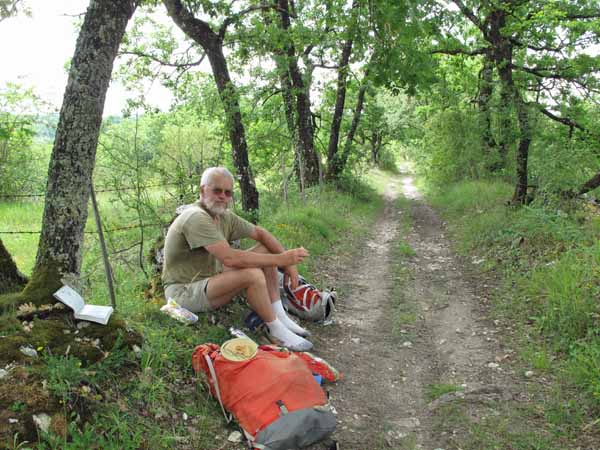
We continued, passing wheat fields and orchards, until we came to a river, marking the border between the departments of the Dordogne and the Lot-et-Garonne.
Shortly after crossing the bridge, we passed a large prune-drying factory and arrived back at the N21, which had taken over the Roman road for itself and was heading straight for Castillonnès.
We could see the village perched on its knoll and we were looking forward to its comforts, so rather than deviate with the GR, we stayed on the highway for a kilometre or so, and then took a sharp, punishing short cut up into the streets.

Castillonnès is a thirteenth-century bastide on a high tongue of rock and because of the lie of the land, it does not have the customary square bastide layout, although it does have an arcaded market place. Its streets are a set of long loops swooping around the promontory.
All of them were deserted and looked grey and dismal after the rain, but as we wandered about we heard sounds of laughter and came to a bar, an island of cheer, with people sitting under an awning on the narrow Grand’Rue. We joined them with alacrity.
The waiter informed us that the camping ground, which was far below the village, was closed, but that there was a hotel just around the corner. This was a relief, as the weather was hardly conducive to camping and we did not feel like retracing our steps so far down.
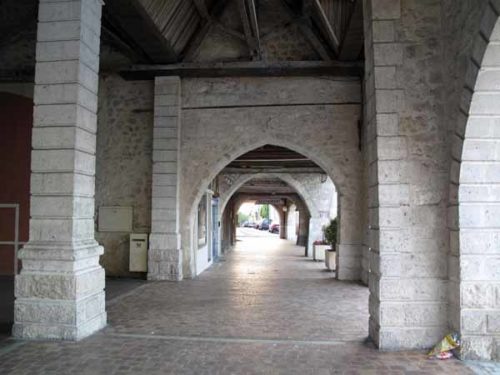
There was thunder approaching by the time we arrived at the hotel. It was called the Hotel des Remparts and was built into the original outer defences of the bastide.
The walled garden was full of guests dining under market umbrellas, an activity that had probably been engaging them for a couple of hours, as it was now 2:15 pm.
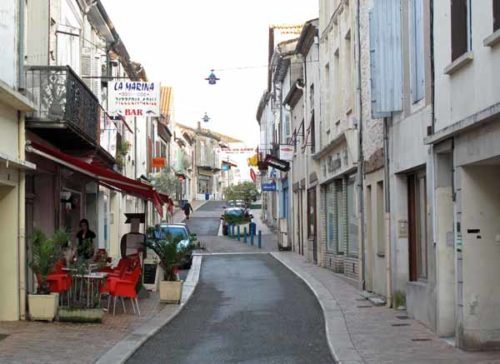
Our affable host showed us to our room, which overlooked the garden, and before we could even unpack there was a monumental rainstorm that sent the diners fleeing.
It was the sort of heavy tumbling rain that makes tracks and camping grounds into quagmires, and was followed by several other storms during the afternoon. Meanwhile we were snug and dry in our lovely room.

The restaurant at the hotel was not open in the evening (the Sunday factor), but our host lent us two umbrellas to venture out in search of dinner. He also offered us a special price for breakfast at the hotel – €5 each instead of the €9 he had quoted before. He must have felt sorry for us as walkers.
Through streets running with water, we picked our way back to the bar in the Grand’Rue, having previously found out that it was open in the evening. This time we went indoors, where there were a great number of people, hardly surprising considering that the two other restaurants in the village were closed.
While our dinner was being cooked we had a glass of rosé and watched the process through the glass door to the kitchen. Keith had a pizza and I had pasta carbonara, both delicious.
A bit later on another couple came in and were told that the kitchen was closed. Altogether it had been a lucky day.
Previous section: Périgueux to Bergerac